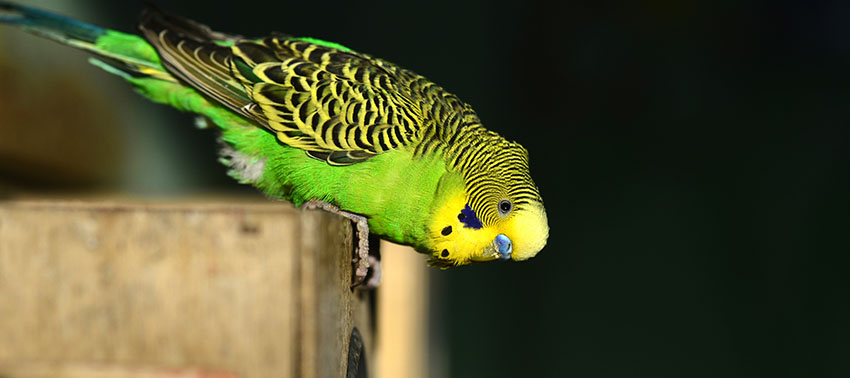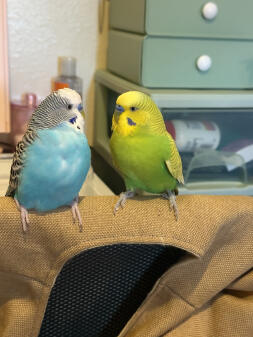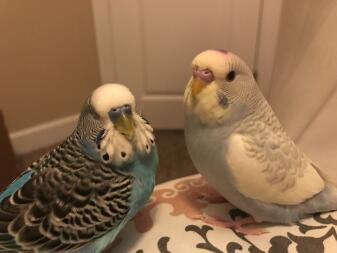If it’s neither too hot nor too cold, if there’s nothing ailing him, and if he’s generally healthy and happy, your budgie will display the following 'typical’ behaviours.
Budgie Wing Stretching
Like any animal, budgies need a good stretch after a long period of inactivity. It’s a good time to admire the bird’s beautiful wing feathers, as he will stretch his leg and wing on one side, then the other. Both wings are then raised, to finish off the exercise and get the blood flowing to the muscles. This will be done in silence, and should not be confused with the aggressive (and noisy) wing-raising behaviour often seen at a crowded food bowl.

Budgies need to stretch their wings
Budgie Head Bobbing
Male budgies enjoy ‘head bobbing’, and watching them in action is very entertaining. The fast and fluid up-and-down motion of the bird’s neck is often accompanied by chattering. If your male bird has a female friend, he will usually demonstrate his ‘rubber’ neck for her benefit – the action is part of his mating display. If allowed to follow its natural progression, a bout of bobbing will escalate into mutual feeding and mating.
Pet budgies, however, are happy to bob their heads at other times too. An outgoing bird (and all budgies have slightly different personalities) will tend to bob more often than a quieter bird. Females occasionally catch the bobbing-bug, but it’s usually males who indulge the habit. They will bob to another male, to you, to a mirror, to a favourite toy, or even to an item of food or a particular section of their cage. Head-bobbing sometimes becomes part of a ritual song and dance. It usually indicates that the budgie is happy and excited.

Head-bobbing is part of a budgie's body language
If you show your appreciation of head-bobbing to a tame bird, he will get into the habit of bobbing to gain your attention. You can never tell exactly what’s passing through a budgie’s mind, but when he’s head-bobbing you can be sure that he’s feeling good.
Baby budgies often head-bob too, to show that they’re hungry. Once weaned and perching with the adult birds, young budgies often cling to their parents in this way for as long as they can, head-bobbing for food. Backed up by the chirrup that means ‘feed me!’, the action usually gets results; but eventually even the most attentive parent will lose interest, and the chicks then have to fight their way to the food trays like everyone else.
Budgie Exercise
First thing in the morning, budgies often flap their wings violently as they perch. Sometimes their feet leave the perch and they perform a noisy hover, warming up their wing muscles and scattering clouds of seed husks and loose feathers. This is nothing to do with display or aggression – they simply need to shake their wings after a long period of rest. They will often accompany the mad flapping with calls and chirrups.
Note: Budgies need to exercise their wings a lot more than this, and if you’re not keeping them in an aviary with space for free flight, you will need to let them fly around in the room outside their cage.
Budgies enjoy gymnastics too, climbing the sides and roof of their cage, and hanging from suspended toys like feathered squirrels.
Budgie Playing With Toys
Your budgie will investigate any item you place in his cage, getting his beak into all its corners and nibbling its edges. Some are more timid than others, and an unadventurous bird might leave a new toy for several hours, or even days, before venturing near. Once the item has been explored thoroughly and played with for a day or two, the bird will lose interest. It’s therefore important to replace old toys with new ones, on a rotational basis.

Budgies need a selection of toys
Anything that hangs from the cage roof and moves around or makes a sound will bring hours of exercise and amusement, as will something that rolls. Many budgies form strong attachments to ping-pong balls, nudging them along the floor with their beaks. A toy with a reflective surface may sometimes trigger a mating response from a bird, especially if he lives alone in his cage. If he begins regurgitating seed to a toy, it’s best to remove the object and let his attention focus elsewhere.
Budgie Obsessed With Bell
Budgies, especially lone birds, become very attached to their toys. A bell, being an item that moves and makes a noise, is often a favourite. Tapping and ringing the bell may become part of your bird’s regular routine, and it can sometimes start to verge on obsessive behaviour. This is a sign that the budgie needs companions. Removing the bell may make him pine; but budgies are adaptable and clever birds, and he will soon recover his poise, and will shift his attention to other areas of his cage. Keeping toys on a rotation basis will prevent any obsessive attachment. But, again, it is best to introduce another bird into your bell-ringing fanatic’s life so that he can channel his feelings in a more natural direction.

Budgies love their bells
Budgie Eye Pinning
A favourite toy, or an exciting new one, may trigger ‘eye pinning’ (sometimes known as eye flashing). This is when the budgie’s pupils dilate and contract rhythmically as he focuses on the interesting object. Pupils also dilate when a cock bird is about to regurgitate to his mate or best friend.
Another sign of an engaged and curious budgie is when he tilts his head to one side to get a good view of whatever he’s looking at.
Budgie Scratching
Although the budgie’s beak manages to reach most places in a preening session, or when scratching an itchy patch of skin, he can’t reach his own face, head and neck. Mutual preening helps out here, where a companion bird deals with the parts his companion’s beak can’t manage. Failing that, the budgie will scratch himself with his foot, or on a toy, perch, or the bars of his cage. For some birds this becomes a pleasurable activity, and they will happily massage their heads and faces in this way on a regular basis.
Budgie Chewing
Budgies love chewing things – it is a natural behaviour that they will seek to satisfy one way or another, so it’s best to provide them with something to chew on. Balsa wood is ideal, as is a stick or wooden perch (made from a suitable wood – see the Budgie Perches section above). Cuttlefish bone doesn’t count as ‘chewable’, as it crumbles to powder as the bird pecks.

Budgies need something to chew on
Budgie Yawning
Budgies, like us, yawn when they’re tired. The beak opens wide, the eyes close, and the neck stretches out. Sometimes the bird will do this several times. It’s nothing to worry about, just a precursor to sleeping. You should only be concerned if the budgie’s beak remains open for long periods, or if he shakes his head or makes coughing sounds. This indicates a problem, possibly a blockage of some type, and you should take him to the vet as soon as possible.
Budgie yawns can be just as contagious as human yawns – you might well find yourself joining in, and pondering on this strange cross-species phenomenon.
Budgie Behaviour in Pairs
Budgies usually enjoy each other’s company, and a pair (whatever the gender of the birds involved) will generally be a self-contained miniature flock, enjoying all the grooming, chattering and socialising natural to their species in the wild.
It’s very unusual, but sometimes a pair of birds will not settle down together happily. They might fight, or they might stay on opposite sides of the cage. There will be no mutual grooming, and they will not sit and chatter together. In these situations the birds should be separated. Sometimes a mirror can help break the ice – the birds will interact with the ‘newcomers’, and that might shift the social balance of the ‘flock’ sufficiently for them to become more friendly.
A bonded pair of birds will display to each other. The cock will sing his best songs and bob his head, and will offer an irresistible lunch of regurgitated seed. The pair will touch their beaks together too, and preen each other on the face and head. The two will tend to stay close, often side by side on a perch.

Two's company for a contented pair of budgies
Budgie Bonding Behaviour
From the moment a budgie moves from its nest to a perch, it is part of the flock, and its behaviour is all about bonding. It will merge its life with the birds around it by doing what they do – eating, grooming, chattering, flying and washing together. A budgie bonds with its neighbours by joining in and enjoying the process. When birds become good friends, they will tap their beaks together in a kind of ‘budgie kiss’, and will preen each other’s face and head.
If you are the budgie’s flock – if you have opted for a single bird and are providing it with all its social stimulation – you will need to reflect these needs. Talk to the bird, bring it out the cage and allow it to sit with/on you as you walk, talk, eat, watch TV, etc. When this is done with the time and dedication it demands, you will have a very happy bird, and will have formed a deep bond with it. Friendship with a tame and socialised bird is every bit as satisfying as time spent with a well-trained pet dog.
Budgie Preening or Grooming
Preening is the budgie’s way of keeping clean and well-groomed. The birds will often do a little grooming of each other, usually in the head and chin areas; but most preening is a solo job. Budgies have a feather-oil gland at the base of their tail, and a preening session consists of taking this oil with the beak and running it down each feather, starting at the point where the feather attaches to the skin. Every feather needs the full treatment, so a preen takes a long time. Budgies often do this together – like most things, they seem to work best when carried out as a flock activity.

A budgie preening
The preening will usually finish with the bird puffing up like a feather-duster and shaking everything into place with a violent shudder. The tail is then swiftly waggled, to add the finishing touches to the preening session.
Budgie Mutual Preening
A budgie is unable to preen its own face and head. He can scratch them with his foot, but nothing beats having a preening companion. Pairs, or any gender combination, will oblige by grooming these out-of-reach places. You can give a finger-trained bird the next best thing by scratching his head with your finger. If he fluffs up his head feathers and closes his eyes, you’re doing well. If he keeps his feathers tight and pecks at your finger, you haven’t got the magic touch he’s looking for.





















Comments
Leca, 4 September 2025
I have four keys, they fly around me all the time. So I always make sure to come close to them and carry a conversation. Listening to my voice, eyes tend to close and just enjoy my company.
Budgie, 12 July 2024
The stretching wing and leg thing when you walk in the room is literally just that, a stretch because you walked into the room. It’s not coincidence, but it’s not quite a greeting. They associate your presence/the cover being lifted etc with some form of activity and if they have been resting or it’s first thing in the morning, they’re stretching in preparation for the activity such as flying to the food for breakfast, getting out of the cage for a bit, maybe doing some training/playing if you do that sort of thing with them. Nothing fancy or complicated going on, just imagine you’ve been sitting for a while then someone says you’re going to do some moving about and you need a good stretch when you stand up. It’s just like that.
Cody, 20 May 2023
We have two male Australian buggies. Every time we go to their cage or walk in the house as there cage is near the door, even when take the cover off from over night. They will put one wing out and stand on one foot and bow head their head as if they’re are greeting us. We have read about wing stretches, which they certainly do and the local bird “expert”at the pet said, they must be stretching and just be good timing each time you see this. This just seems to happen to offend at the same times. It’s literally like they are saying hello. We have are other buggie owners, I’ve even filmed it to show people. No seems to know. Is there anyone that knows about this behaviour or is it a case of them just greeting us?
Smith, 4 October 2021
I have a budgie mostly white and not albino who will sit on the one and one half...2 inches around round yellow plastic dish I put wet food in including egg yolk in it....and wiggle its bum on it with its wi gs away from its body. Is this bird exhibiting a female or male behaviour and what is this budgie doing. Second quesyion I am trying to sort which is female and which male. I have been observing who kisses who and who will not kiss who to discern this. Is their kissing together relevant to what sex they are. Was trying to do a deduction knowing one set that is a pair. The rest are still swinging partners but very happy.
Christi, 17 May 2021
Hello I bought to parakeet babies. Their stripes come all the way down to the beak and I read that means they’re younger than 4 mo. I started working with hand taming from day one I kept them out of their cage as much as possible and was able to hand feed them from day one. I do this daily but it seems as soon as they loose interest in eating they fly away and I only can get them to land on me with a treat in hand. I’ve had them only one week. Will they grow to love me and come to me without treats and only to eat?